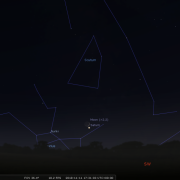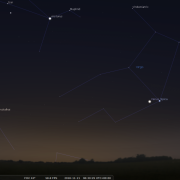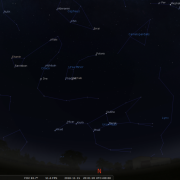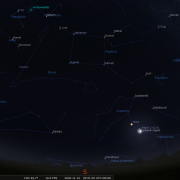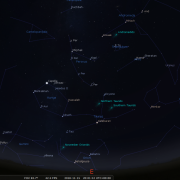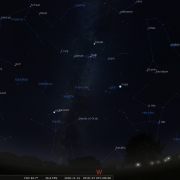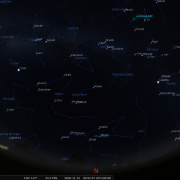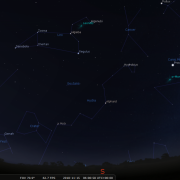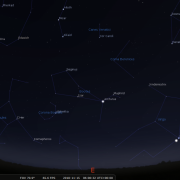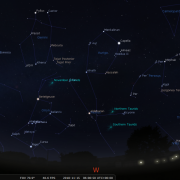In this month's Sky Notes:
Planetary Skylights
Evening
 Jupiter finally departs the evening sky during late November, but is so low and above the SW horizon for less than 30mins it’s hardly worth bothering with.
Jupiter finally departs the evening sky during late November, but is so low and above the SW horizon for less than 30mins it’s hardly worth bothering with.

 Saturn is now slipping down toward the SW horizon and by the month’s end will only be visible for around half an hour after sunset, so make the most of any observing opportunities during early November. View on the 11th when Saturn is in a close and pleasing conjunction with The Crescent Moon. Telescopically, the image of Saturn will gradually deteriorate as it drops into ever more turbulent air near the horizon, but have patience and clearer glimpses of the rings will resolve. A speck of light nearby is Saturn’s major moon, Titan.
Saturn is now slipping down toward the SW horizon and by the month’s end will only be visible for around half an hour after sunset, so make the most of any observing opportunities during early November. View on the 11th when Saturn is in a close and pleasing conjunction with The Crescent Moon. Telescopically, the image of Saturn will gradually deteriorate as it drops into ever more turbulent air near the horizon, but have patience and clearer glimpses of the rings will resolve. A speck of light nearby is Saturn’s major moon, Titan.
 The unmistakable and conspicuous orange hue of Mars rides low in the south as twilight falls. During November Mars rapidly moves through the tail end of Capricornus and up into Aquarius, keeping ahead of the brighter twilight and moving higher into the sky than it has so far been this year. Telescopically the Martian disk will however appear only half the size it did at opposition in July as the distance between our two worlds grows ever greater. That said ‘seeing’ will be a little more stable and surface detail (darker areas and the polar caps) will be apparent through the eyepiece of modest or larger scopes. View on the 15th and 16th when The Moon lies nearby.
The unmistakable and conspicuous orange hue of Mars rides low in the south as twilight falls. During November Mars rapidly moves through the tail end of Capricornus and up into Aquarius, keeping ahead of the brighter twilight and moving higher into the sky than it has so far been this year. Telescopically the Martian disk will however appear only half the size it did at opposition in July as the distance between our two worlds grows ever greater. That said ‘seeing’ will be a little more stable and surface detail (darker areas and the polar caps) will be apparent through the eyepiece of modest or larger scopes. View on the 15th and 16th when The Moon lies nearby.
 Having not long reached opposition, Uranus, at magnitude +5.65 is readily visible in binoculars; however, to discern its small disk, which is grey/green in hue, a telescope will be needed. During mid evening Uranus is located across in the south east approximately two degrees to the left of the star Omicron Piscis; Torcularis Septentrionalis, although Uranus actually lies in the extreme lower right corner of Aries. The stars Sheratan and Mesarthim point down to Omicron piscis. The Gibbous Moon lies around five degrees below Uranus on the 20th.
Having not long reached opposition, Uranus, at magnitude +5.65 is readily visible in binoculars; however, to discern its small disk, which is grey/green in hue, a telescope will be needed. During mid evening Uranus is located across in the south east approximately two degrees to the left of the star Omicron Piscis; Torcularis Septentrionalis, although Uranus actually lies in the extreme lower right corner of Aries. The stars Sheratan and Mesarthim point down to Omicron piscis. The Gibbous Moon lies around five degrees below Uranus on the 20th.
 Neptune is located in the SSW within the constellation of Aquarius, approximately a binocular field lower left of the asterism known as the ‘water jar’ and the a few degrees to the left of Lamda Aquarii. You will require a telescope to identify it, appearing as a tiny blue/grey disk. Look for it just below-left of 81 Aqr. The Moon resides in line and around 4 degrees to the left of Neptune on the 17th Next month Mars and Neptune will have a splendid conjunction, a great opportunity to track down the outermost major planet.
Neptune is located in the SSW within the constellation of Aquarius, approximately a binocular field lower left of the asterism known as the ‘water jar’ and the a few degrees to the left of Lamda Aquarii. You will require a telescope to identify it, appearing as a tiny blue/grey disk. Look for it just below-left of 81 Aqr. The Moon resides in line and around 4 degrees to the left of Neptune on the 17th Next month Mars and Neptune will have a splendid conjunction, a great opportunity to track down the outermost major planet.
Morning
 Venus makes a dazzling return into the dawn sky and will be visible low in the SE aspect. If you view around 06:30h throughout the month, notice how Venus glides up to the bright star Spica in Virgo, reaching it by the 16th, before turning to the east and moving away. A very slim waning Moon lies off to the upper left on the 6th.
Venus makes a dazzling return into the dawn sky and will be visible low in the SE aspect. If you view around 06:30h throughout the month, notice how Venus glides up to the bright star Spica in Virgo, reaching it by the 16th, before turning to the east and moving away. A very slim waning Moon lies off to the upper left on the 6th.
Meteors

The Leonids are active from Nov 15-20th with the 2018 peak expected to last over the 17th and 18th. A waxing moon will be visible during the evening, so perhaps wait until after it has set, making post midnight, or the early morning hours of the 17th and 18th the optimum time to observe (the best time anyway)
Leonids are associated with the periodic comet Temple Tuttle, which has an orbital period of 33yrs. The orbit intersects Earth’s and over thousands of years the debris stream deposited by each pass of the comet has been swept into complex strands. At roughly 33yr intervals, Earth ploughs through the latest dense strand of material giving rise to ‘storm’ levels of meteor activity. The last ones occurred in 1998 and 1999, when from far Asia peak rates were estimated to be in the low thousands per hour. This year, however is again a normal peak rate one, so expect early morning levels of around 10-15 per hour. The next Leonid ‘storm’ is not due until 2030.
Also during November keep an eye out for a few meteors on the night of Nov 4/5th when the South Taurid meteor shower reaches a peak, and then again on the night of Nov 11/12 when the North Taurid meteor shower peaks. The hourly rate is low; - only around 5 meteors, but although few, Taurids can be very bright with occasional fireballs! The Taurids are an old shower, associated with the periodic Comet Enke. Over time dust from this comet has been depleted and spread out over a broad swath of the inner solar system, giving rise to Taurid meteor showers not only on Earth but also on Mars and Venus too!
Comets
Comet 46P/Wirtanen continues to gradually ‘brighten’ although as yet is not well placed for UK observers. This is a short-period comet who’s orbit takes 5.4 years and is rather small being just over 1km in diameter. 46P/Wirtanen was actually the original target for ESA’s Rosetta spacecraft, but the launch window was missed so 67P/Churymov-Gerasimenko was chosen instead.
Comet 46P/Wirtanen is expected to become a naked eye object by early/mid December, perhaps reaching magnitude +4.5 around perihelion passage on 16 December when it will pass 0.078 AU (7,220,000miles) from Earth. At this point comet 46P will be Taurus, quite near the Pleiades star cluster. Currently at mag + (to update) during late November the 46P resides in Cetus before moving into Eridarnus. Comet update next month.
November 2018 Sky Charts
|
Looking North
Mid-November - 20:00h |
Looking South |
|
Looking East
Mid-November - 20:00h |
Looking West
Mid-November - 20:00h |
|
Northern Aspect
12-Oct-2018 at 20:00h |
Southern Aspect
12-Oct-2018 at 20:00h |
| Looking North (Early) Mid-November - 06:00h |
Looking South (Early) Mid-November - 06:00h |
| Looking East (Early) Mid-November - 06:00h |
Looking West (Early) Mid-November - 06:00h |
Additional Image Credits:
- Planets and Comets where not otherwise mentioned: NASA
- Sky Charts: Stellarium Software
- Log in to post comments

